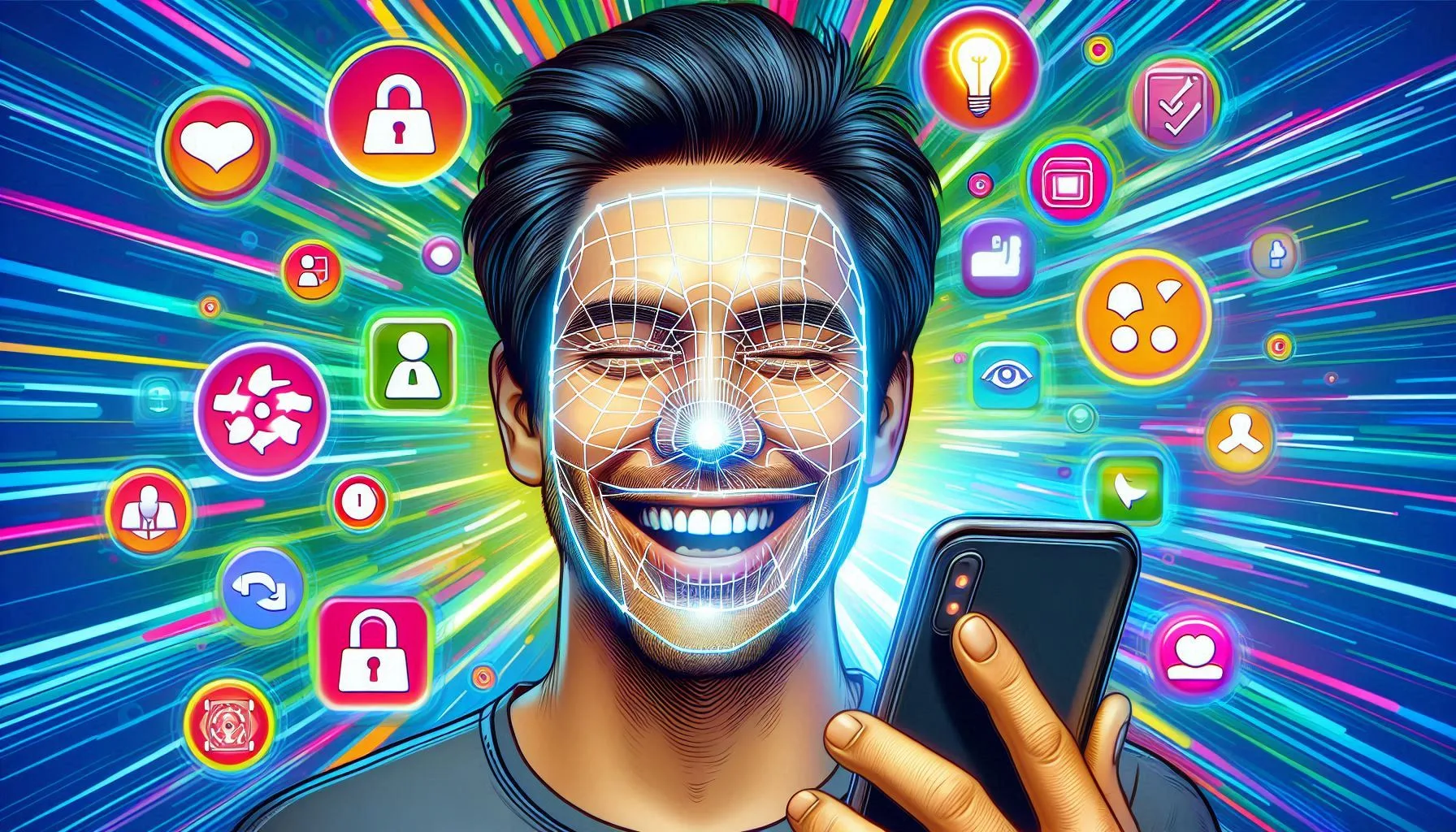Face recognition technology has revolutionized security systems, mobile devices, and various applications across industries. This comprehensive guide delves into the intricacies of how face recognition works, explores Apple’s 3D face recognition technology, and provides valuable resources for programmers interested in implementing this cutting-edge technology.
Understanding the Basics of Face Recognition
Face recognition is a biometric technology that identifies or verifies a person’s identity using their facial features. The process involves capturing, analyzing, and comparing patterns based on the person’s facial contours.
Key Steps in Face Recognition:
- Face Detection: The system locates and isolates a face within an image or video stream.
- Feature Extraction: It analyzes facial features, such as the distance between eyes, nose shape, and jawline.
- Feature Comparison: The extracted features are compared against a database of known faces.
- Identity Matching: The system determines if the face matches a known identity or classifies it as unknown.
The Science Behind Face Recognition
Face recognition relies on complex algorithms and machine learning techniques to achieve accurate results. Let’s explore the underlying technologies that make this possible.
Computer Vision
Computer vision forms the foundation of face recognition systems. It enables machines to interpret and understand visual information from the world around them. In face recognition, computer vision algorithms process digital images or video frames to detect and analyze facial features.
Machine Learning and Deep Learning
Machine learning algorithms, particularly deep learning models, play a crucial role in face recognition systems. These algorithms learn from vast datasets of facial images to recognize patterns and features that distinguish one face from another.
Convolutional Neural Networks (CNNs)
CNNs are a type of deep learning model particularly well-suited for image analysis. They use layers of interconnected nodes to process visual data, automatically learning to extract relevant features from facial images.
Feature Extraction Techniques
Face recognition systems employ various feature extraction methods to create a unique “facial signature” for each individual. Some common techniques include:
- Eigenfaces: This method uses principal component analysis (PCA) to represent faces as a combination of base faces.
- Local Binary Patterns (LBP): LBP analyzes texture patterns in facial images to create a compact feature representation.
- Histogram of Oriented Gradients (HOG): HOG captures edge and gradient structures that are characteristic of local shape.
Apple’s 3D Face Recognition: Face ID
Apple’s Face ID technology, introduced with the iPhone X, represents a significant advancement in face recognition for mobile devices. Let’s examine how this 3D face recognition system works and what sets it apart from traditional 2D methods.
TrueDepth Camera System
At the heart of Face ID is the TrueDepth camera system, which consists of several components:
- Dot Projector: Projects over 30,000 invisible infrared dots onto the user’s face.
- Infrared Camera: Captures an infrared image of the dot pattern.
- Flood Illuminator: Emits infrared light to enable face detection in low-light conditions.
How Face ID Works
- Face Detection: When you glance at your iPhone, the TrueDepth camera system activates and looks for a face.
- 3D Mapping: The dot projector creates a 3D map of your face by projecting and analyzing the infrared dot pattern.
- Image Capture: The infrared camera captures an infrared image of your face.
- Data Conversion: The captured facial data is converted into a mathematical representation.
- Comparison: This representation is compared to the enrolled facial data stored in the Secure Enclave.
- Authentication: If the data matches, the device unlocks or authorizes an action.
Advantages of 3D Face Recognition
Apple’s 3D face recognition offers several benefits over traditional 2D methods:
- Enhanced Security: The 3D mapping makes it extremely difficult to fool the system with photos or masks.
- Improved Accuracy: 3D facial features provide more data points for comparison, reducing false positives and negatives.
- Adaptability: Face ID can adapt to changes in appearance, such as growing a beard or wearing glasses.
- Low-light Performance: The system works effectively in various lighting conditions, including complete darkness.
Advanced Face Recognition Techniques
As face recognition technology continues to evolve, researchers and developers are exploring advanced techniques to improve accuracy, speed, and security.
Multi-modal Biometrics
Combining face recognition with other biometric modalities, such as fingerprint or voice recognition, can enhance overall system performance and security.
Liveness Detection
To prevent spoofing attempts, advanced face recognition systems incorporate liveness detection techniques. These methods verify that the face being scanned belongs to a live person rather than a photo or video recording.
Common Liveness Detection Methods:
- Blink Detection: Checking for natural eye blinking patterns.
- Facial Expression Analysis: Prompting the user to perform specific facial movements.
- Texture Analysis: Examining skin texture and patterns that are difficult to replicate in fake images.
Facial Recognition in Video Streams
Real-time face recognition in video streams presents unique challenges and opportunities. Advanced systems use techniques like:
- Temporal Coherence: Analyzing facial features across multiple video frames to improve accuracy.
- Motion Estimation: Predicting face positions in subsequent frames to optimize processing.
Privacy-preserving Face Recognition
As concerns about data privacy grow, researchers are developing privacy-preserving face recognition techniques:
- Homomorphic Encryption: Allows computations on encrypted data without decrypting it.
- Federated Learning: Enables model training across multiple devices or servers without sharing raw data.
Face Recognition for Programmers
For developers interested in implementing face recognition in their projects, several libraries, plugins, and programming languages offer powerful tools and resources.
Popular Face Recognition Libraries
- OpenCV: An open-source computer vision library with face detection and recognition capabilities.
- dlib: A C++ library with Python bindings, known for its accurate facial landmark detection.
- face-recognition: A Python library built on dlib, offering a simple interface for face recognition tasks. (GitHub)
Face Recognition APIs
- Amazon Rekognition: A cloud-based service that provides face detection, analysis, and comparison features.
- Google Cloud Vision API: Offers face detection and emotion recognition capabilities.
- Microsoft Azure Face API: Provides face detection, verification, and identification services.
Programming Languages for Face Recognition
While face recognition can be implemented in various programming languages, some are particularly well-suited for this task:
- Python: With its extensive machine learning libraries and easy-to-use syntax, Python is a popular choice for face recognition projects.
- C++: Offers high performance and low-level control, making it suitable for resource-constrained environments.
- Java: Provides a good balance of performance and ease of use, with libraries like OpenIMAJ for face recognition tasks.
Implementing Face Recognition: A Basic Python Example
Here’s a simple example using the `face_recognition` library in Python to detect and recognize faces in an image:
Python
import face_recognition
import cv2
# Load sample images and learn how to recognize them
known_image = face_recognition.load_image_file("known_person.jpg")
known_face_encoding = face_recognition.face_encodings(known_image)[0]
# Load an unknown image
unknown_image = face_recognition.load_image_file("unknown.jpg")
# Find all faces and face encodings in the unknown image
face_locations = face_recognition.face_locations(unknown_image)
face_encodings = face_recognition.face_encodings(unknown_image, face_locations)
# Loop through each face found in the unknown image
for (top, right, bottom, left), face_encoding in zip(face_locations, face_encodings):
# Check if the face matches the known face
matches = face_recognition.compare_faces([known_face_encoding], face_encoding)
if matches[0]:
# Draw a box around the face
cv2.rectangle(unknown_image, (left, top), (right, bottom), (0, 255, 0), 2)
# Display the resulting image
cv2.imshow('Face Recognition', unknown_image)
cv2.waitKey(0)This example demonstrates face detection, encoding, and comparison using the `face_recognition` library. It’s a starting point for more complex face recognition applications.
Ethical Considerations and Future Trends
As face recognition technology becomes more prevalent, it’s crucial to consider its ethical implications and potential future developments.
Privacy Concerns
The widespread use of face recognition raises significant privacy concerns. Developers and organizations must implement strong data protection measures and obtain proper consent for collecting and using facial data.
Bias and Fairness
Face recognition systems can exhibit bias, particularly in recognizing faces of different ethnicities or genders. Ongoing research focuses on developing more inclusive and fair algorithms.
Regulation and Compliance
Governments worldwide are implementing regulations governing the use of facial recognition technology. Developers must stay informed about legal requirements in their jurisdictions.
Future Trends in Face Recognition
- Edge Computing: Processing face recognition on-device to enhance privacy and reduce latency.
- Emotion Recognition: Advancing beyond identity verification to detect emotional states.
- Augmented Reality Integration: Combining face recognition with AR for enhanced user experiences.
Conclusion: Face recognition technology has come a long way, from basic 2D image analysis to sophisticated 3D mapping techniques like Apple’s Face ID. As the field continues to evolve, it offers exciting opportunities for developers to create innovative applications across various industries.
By understanding the underlying principles, exploring available tools and libraries, and considering ethical implications, programmers can harness the power of face recognition technology responsibly and effectively. Whether you’re building a security system, a user authentication solution, or a creative application, face recognition opens up a world of possibilities for enhancing user experiences and solving complex problems.




